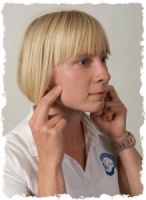
Q: Do you have any advice for helping preschoolers begin to use two-word combinations? The best way I ever have found to stimulate two-word combinations is to model them melodically following the basic research done on Melodic Intonation Therapy (see resources below) — this research was done with adults, but people have applied it to kids ever since it first came out. I use a two-tone high-low melodic pattern. Model the first word on the high tone, and the second…



